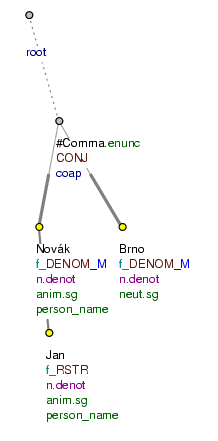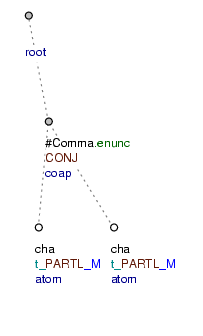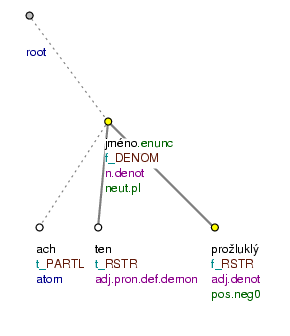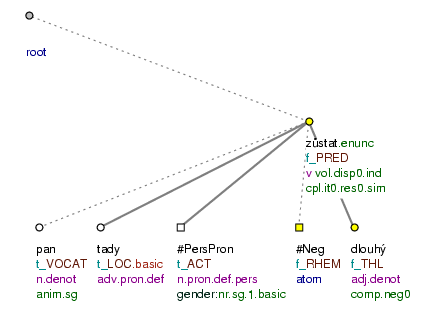Verbal and non-verbal clauses can be combined in two ways: either by a dependency relation or by a non-dependency relation (paratactic connection).
Non-dependency. We distinguish several cases in which verbal and non-verbal clauses are combined in non-dependency relations:
-
paratactic connection. The clauses are connected in a paratactic connection - coordination or apposition - if none is dependent on each other.
For the annotation rules regarding paratactic structures, see Section 6, "Parataxis".
The following cases are considered paratactic connections:
-
verbal clause + verbal clause.
Examples:
Kočka je.
PRED[is_member=1] savec, ale savcem je.PRED[is_member=1] i velryba. (=The cat is a mammal but the whale is a mammal as well)Víme, že kočka je.
PAT[is_member=1] savec a že savcem je.PAT[is_member=1] i velryba. (=We know that the cat is a mammal and the whale is a mammal as well) -
nominative clause + nominative clause.
Example:
Jan Novák.
DENOM[is_member=1] , Brno.DENOM[is_member=1] Fig. 6.32Na konec dopisu napsal: Jan Novák.
EFF[is_member=1] , Brno.EFF[is_member=1] (=He wrote at the end of the letter: Jan Novák, Brno) -
vocative clause + vocative clause.
Example:
Milý Jirko.
VOCAT[is_member=1] , milý Petře.VOCAT[is_member=1] ! (=Dear Jirka, dear Petr!) -
interjectional clause + interjectional clause.
Example:
Cha.
PARTL[is_member=1] , cha.PARTL[is_member=1] . Fig. 6.33 -
verbal clause + nominative clause.
Example:
Recenze.
DENOM[is_member=1] knihy : Novou knihou jsou.PRED[is_member=1] Rozbité obrazy. (=Review: A new book is Rozbité obrazy) Fig. 6.34A pak napsal: Recenze.
EFF[is_member=1] knihy : Novou knihou jsou.EFF[is_member=1] Rozbité obrazy. (=And then he wrote: Review: A new book is Rozbité obrazy) -
vocative clause + interjectional clause.
Example:
Ach.
PARTL[is_member=1] , Jirko.VOCAT[is_member=1] ! (=Oh, Jirka!)
-
-
special non-dependency relations. A non-dependency connection of a verbal or nominative clause with an interjection or vocative clause is not considered a paratactic connection but rather a special non-dependency relation.
The effective root node of the interjectional or vocative clause is represented as dependent on the effective root node of the verbal or nominal clause. The fact that these are not real cases of dependency can be deduced from the used functor, i.e.
PARTLorVOCAT.The following cases, then, are represented in this way:
-
verbal clause + interjectional clause.
Examples:
Ejhle.
PARTL, to byla.PREDprávě ta kapička. (=Oh, this was the droplet) Fig. 6.35Zvolal: Ejhle.
PARTL, to byla.PATprávě ta kapička. (=He cried: Oh, this was the droplet) -
verbal clause + vocative clause.
Examples:
Pane.
VOCAT, nehodlám.PREDtu zůstat déle. (=Sir, I am not going to stay here any longer) Fig. 6.37Odpověděl: Pane.
VOCAT, nehodlám.EFFtu zůstat déle. (=He answered: Sir, I am not going to stay here any longer)!!! At the moment, there is no way to distinguish cases where the noun in the vocative is identical in reference with the subject of the verbal clause (e.g.: Pane, vyslyš mě. (=Lord, answer my prayers)) from cases where there is no such identity in reference (e.g.: Pane, nehodlám tu zůstat déle. (Sir, I am not going to stay here any longer)).
-
nominative clause + interjectional clause.
Examples:
Ach.
PARTL, ta prožluklá jména.DENOM(=Oh, those bloody names!) Fig. 6.36Zvolal: Ach.
PARTL, ta prožluklá jména.PAT(=He cried: Oh, those bloody names!) -
nominative clause + vocative clause.
Example:
Jirko.
VOCAT, voda.DENOM! (=Jirka, water!)Zavolal: Jirko.
VOCAT, voda.PAT! (=He called: Jirka, water!)
-
-
parenthesis. Parentheses also constitute cases of non-dependency relations.
The effective root node of a parenthetical clause is represented as dependent on the node which is most directly linked to the parenthesis. The fact that this is no dependency relation can be seen from the functor assigned to the effective root node of the parenthetical clause; i.e. either
PARfor a verbal or nominative clause, orVOCATorPARTLfor a vocative or interjectional clause).For the annotation rules regarding parentheses, see Section 7, "Parenthesis".
Dependency. The basic type of clause connection that makes use of dependency relations is:
-
complex sentence. A complex sentence is a connection of two or more verbal clauses, based on a dependency relation. I.e. the combination:
-
governing verbal clause + dependent verbal clause.
The effective root node of the dependent clause is assigned a functor according to the type of the dependency relation it has w.r.t. the governing clause.
For more on the annotation of dependent verbal clauses, see Section 5, "Dependent verbal clauses".
-
Special cases of dependency relations:
-
dependent direct speech. All types of clauses can be used as direct speech, i.e. can occur in an argument position of a verb of saying etc.
The effective root node of the direct speech is assigned the functor corresponding to the relevant argument of the governing verb - if the direct speech is expressed by a verbal or nominative clause. If the direct speech is represented by a vocative or interjectional clause, the effective root node of the direct speech is a node for an empty verb and the effective root node of the clause is represented as dependent on the node.
For the annotation rules regarding direct speech, see Section 3, "Direct speech".
-
the nominative of identity. All types of clauses can occur in the position of the nominative of identity.
The effective root node of any clause in the position of the nominative of identity has always the
IDfunctor.For detailed description of the rules see Section 8.1, "Basic rules for the annotation of identifying expressions".
Figure 6.34. Paratactic connection of a nominative and verbal clause
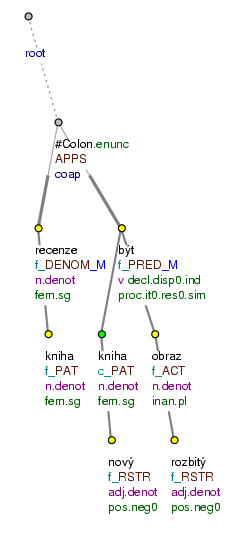
Recenze knihy: Novou knihou jsou Rozbité obrazy. (=lit. Review (of) book: New book is Rozbité obrazy)
Figure 6.35. Connection of an interjectional and verbal clause
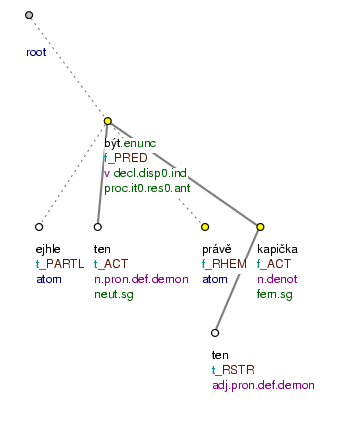
Ejhle, to byla právě ta kapička. (=lit. Oh, this was just the droplet)
